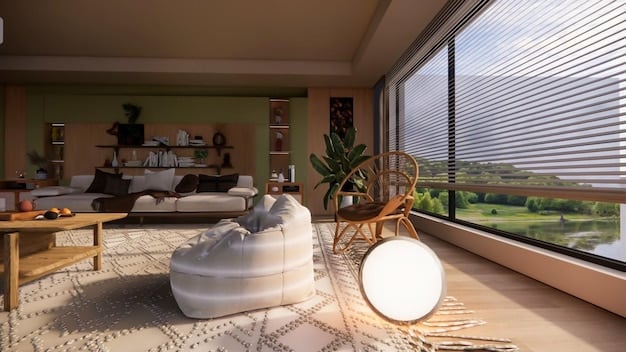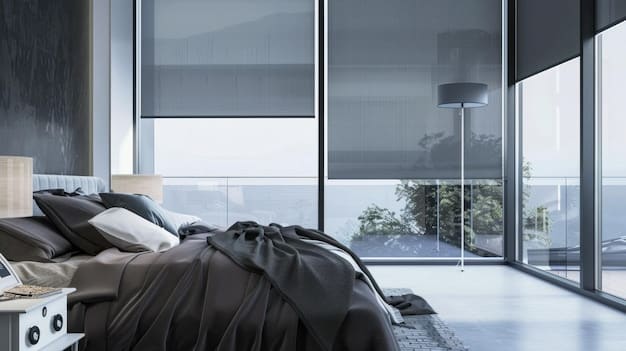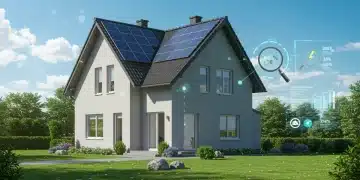Smart Blinds and Shades: Automate Your Home, Enhance Privacy

Smart blinds and shades offer a modern solution to automate natural light and privacy in your home, providing convenience, energy efficiency, and enhanced security through programmable settings and smart home integration possibilities.
Imagine waking up to the gentle sunlight filtering through your windows, or automatically adjusting your shades to block out the harsh afternoon glare. Smart blinds and shades bring this convenience and more, automating your home’s natural light and privacy with ease. Let’s explore how these innovative solutions can transform your living space.
Understanding the Basics of Smart Blinds and Shades
Smart blinds and shades are motorized window coverings that can be controlled remotely via a smartphone app, voice command, or a smart home hub. They offer a blend of convenience, energy efficiency, and enhanced privacy compared to traditional blinds and shades.
These automated systems eliminate the need for manual operation, providing programmable settings that adjust based on time of day, sunlight intensity, or even your personal preferences. This not only simplifies your daily routine but also contributes to a more energy-efficient home.
Key Components of a Smart Blind System
Understanding the components that make up a smart blind system can help you make an informed decision when choosing the right option for your home.
- Motorized Shades: These are the core of the system, responsible for the physical movement of the blinds or shades.
- Control Hub: This device acts as the central command center, connecting the blinds to your home network and allowing for remote control.
- Smartphone App: The app provides a user-friendly interface to manage and schedule the blinds from anywhere.
- Voice Control Integration: Many systems offer integration with voice assistants like Amazon Alexa or Google Assistant for hands-free control.
By understanding these components, you’ll be better equipped to select a system that meets your specific needs and integrates seamlessly into your smart home ecosystem.
In essence, smart blinds and shades offer a sophisticated and convenient way to manage natural light and privacy in your home, combining technology with everyday functionality.
Benefits of Automating Your Window Treatments
Automating your window treatments with smart blinds and shades offers a multitude of benefits beyond just convenience. From energy savings to enhanced home security, the advantages are considerable.
These systems provide precise control over natural light, allowing you to optimize your home’s temperature and reduce reliance on artificial lighting. This can lead to significant savings on your energy bills while also creating a more comfortable and inviting living environment.

Enhanced Energy Efficiency
One of the most significant benefits of smart blinds is their ability to improve energy efficiency. By scheduling the blinds to open and close based on the sun’s position, you can minimize solar heat gain in the summer and maximize it in the winter.
This helps to regulate your home’s temperature, reducing the workload on your HVAC system and lowering your energy consumption.
Improved Home Security
Smart blinds can also play a role in enhancing your home security. By automatically adjusting the blinds at set times, you can create the illusion that someone is home, even when you’re away. This can deter potential burglars and provide added peace of mind.
- Programmable Schedules: Set schedules to mimic your daily routine, making it appear as if someone is always home.
- Remote Control: Use the smartphone app to adjust the blinds from anywhere in the world.
- Integration with Security Systems: Integrate your smart blinds with your existing security system for a more comprehensive security solution.
Ultimately, automating your window treatments with smart blinds and shades offers a blend of convenience, energy savings, and enhanced security, making it a worthwhile investment for any modern homeowner.
Choosing the Right Smart Blinds for Your Home
Selecting the right smart blinds and shades for your home involves considering a variety of factors, including your budget, aesthetic preferences, and functional needs. With a wide range of options available, it’s important to do your research and choose a system that aligns with your lifestyle.
From roller shades to Venetian blinds, there are different styles to match your home décor. Also, consider the power source: Some are battery-powered while others require wiring. Assess your needs before making a decision.

Types of Smart Blinds and Shades
Understanding the different types of smart blinds and shades available is crucial for making an informed decision. Each style offers unique benefits and aesthetic qualities.
Roller Shades: These are a popular choice for their sleek and modern design. They roll up and down smoothly and can be customized with a variety of fabrics and colors.
- Venetian Blinds: Offer excellent light control with adjustable slats that can be tilted to different angles.
- Cellular Shades: Known for their energy efficiency, these shades feature a honeycomb design that traps air and provides insulation.
- Roman Shades: Combine the elegance of drapery with the functionality of shades, offering a soft and sophisticated look.
By exploring these different options, you can find the perfect smart blinds or shades to complement your home’s décor and meet your specific light control and privacy needs.
Think about your long-term goals, such as energy savings, security, and convenience, and choose the system that best aligns with your priorities.
Installation and Setup: What to Expect
The installation and setup of smart blinds and shades can vary depending on the system you choose. While some systems are designed for DIY installation, others may require professional assistance.
Understanding the installation process and what to expect can help you prepare and ensure a smooth and hassle-free setup. Whether you opt for a DIY approach or hire a professional, proper installation is crucial for optimal performance and longevity.
DIY vs. Professional Installation
Deciding whether to install your smart blinds yourself or hire a professional depends on your technical skills and comfort level. DIY installations can save you money, but professional installations offer expertise and peace of mind.
DIY Installation: This option is suitable for those with basic handyman skills and a good understanding of electrical wiring. Most DIY kits come with detailed instructions and online support.
Factors to Consider Before Installation
Before you begin the installation process, there are several factors to consider to ensure a smooth and successful setup.
- Power Source: Determine whether your blinds will be battery-powered or wired into your home’s electrical system.
- Window Measurements: Accurately measure your windows to ensure the blinds fit properly.
- Smart Home Compatibility: Check that the blinds are compatible with your existing smart home ecosystem.
By carefully considering these factors, you can streamline the installation process and avoid potential issues.
Ultimately, careful planning and proper execution are the keys to a successful smart blind installation. Regardless of your chosen approach, the result will be a more convenient, efficient, and secure home environment.
Integrating Smart Blinds with Your Smart Home Ecosystem
One of the most compelling features of smart blinds and shades is their ability to integrate seamlessly with your existing smart home ecosystem. This integration allows you to control your window treatments alongside other smart devices, creating a truly automated and connected home environment.
From voice control to automated scenes, the possibilities are endless. Explore the various integration options and take your smart home to the next level.
Benefits of Smart Home Integration
Integrating your smart blinds with your smart home ecosystem unlocks a range of benefits that enhance convenience, comfort, and energy efficiency.
Voice Control: Use voice commands to adjust your blinds with ease. Simply say, “Alexa, close the blinds,” and watch as your window treatments respond instantly.
Popular Smart Home Platforms
Several popular smart home platforms offer seamless integration with smart blinds and shades. Some of the most prominent include:
- Amazon Alexa: A widely used voice assistant that can control a vast array of smart home devices, including smart blinds.
- Google Assistant: Similar to Alexa, Google Assistant allows you to control your blinds using voice commands.
- Apple HomeKit: Apple’s smart home platform offers integration with Siri and allows you to control your blinds using your iPhone, iPad, or Apple Watch.
By integrating your smart blinds with these platforms, you can create a cohesive and automated smart home experience.
By leveraging the power of smart home integration, you can create a living environment that is both convenient and energy efficient.
Troubleshooting Common Issues with Smart Blinds
While smart blinds and shades are generally reliable, like any electronic device, they can sometimes encounter issues. Knowing how to troubleshoot common problems can save you time and frustration.
From connectivity issues to motor malfunctions, understanding the most common problems and their solutions can help you keep your smart blinds running smoothly. Let’s explore some common issues and troubleshooting tips.
Connectivity Problems
Connectivity issues are among the most common problems encountered with smart blinds. These can manifest as the blinds not responding to commands or losing connection to the control hub. Make sure the control hub is connected to the internet.
Motor Malfunctions: In time, you might experience problems with the motor.
Troubleshooting Tips
Here are some troubleshooting tips to help you resolve common issues with your smart blinds:
- Check the Power Supply: Ensure that the blinds are properly connected to a power source or that the batteries are not depleted.
- Restart the Control Hub: Try restarting the control hub to refresh the connection with the blinds.
- Update the Firmware: Keep the firmware of your smart blinds and control hub up to date to ensure compatibility and optimal performance.
By following these troubleshooting tips, you can quickly resolve common issues and keep your smart blinds operating smoothly.
By being proactive and addressing issues promptly, you can ensure that your smart blinds provide years of reliable service.
| Key Point | Brief Description |
|---|---|
| 💡 Automation | Automated schedules for light and privacy. |
| 💰 Energy Savings | Reduce energy consumption and lower bills. |
| 🔒 Security | Enhanced home security with timed operation. |
| 🔗 Smart Home | Seamless integration with existing smart devices. |
FAQ: Smart Blinds and Shades
▼
Smart blinds offer convenience through automated schedules, energy savings by optimizing sunlight, and enhanced security with programmed operation when you are away from home.
▼
Some smart blinds systems are designed for DIY installation, while others may require professional installation. Consider your comfort level with electrical work and follow manufacturer instructions/get professional help.
▼
Smart blinds can connect with systems like Amazon Alexa, Google Assistant, and Apple HomeKit, allowing you control blinds with your voice, and create automated scenes.
▼
Yes, smart blinds reduce energy use by adjusting to sunlight and heat, which minimizes the need for artificial cooling/lighting, leading to utility bill savings in the long run.
▼
Smart blinds come with options that include battery, wired, and even solar-powered. Each offers different benefits, depending on your energy needs/location of the home.
Conclusion
Smart blinds and shades bring modern convenience and efficiency to your home, automating light and privacy while offering many benefits such as energy savings and improved home security. Choosing the right system and understanding its integration with your smart home devices ensures you will enjoy a more efficient and comfortable living space.





